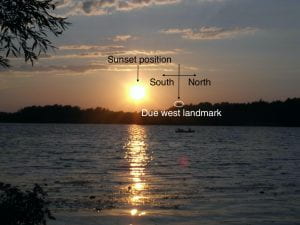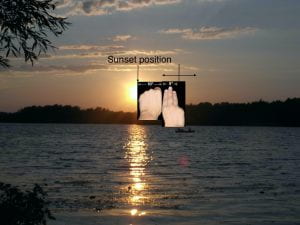Sunsets and The Moon
For this project, you will directly observe some of the things we’ve been talking about in class, namely the position of the setting Sun over the course of the seasons and the changing phases of the Moon. Think of this as your opportunity to pay closer attention to the sky than perhaps
you ever have.
|
|
Project Outline
- The project consists of making 7 short observations of the sky around the time of sunset, each separated by at least one week. Note that you will only do one observation each evening you venture out, and that observation needs to be 10-45 minutes BEFORE sunset. DO NOT record another observation later that night if you don’t see the Moon at this time. (You are welcome to look for the Moon later, and that very well may help you understand the lunar phases better, just don’t record those data for this project!)
- You can find sunset times by just typing “sunset time” into Google.
- The due dates for each observing session occur every 2 weeks throughout the semester and are specified on Blackboard. You’ll notice that the entry forms will appear on Blackboard accordingly.
- In the Blackboard form for each observation, you will be asked the same Observation Questions about what you observed.
- Once you have made all the observations for the semester, you will answer some Summary Questions. These will be submitted to Blackboard. In answering the Summary Questions, try to apply what you learned earlier in the course. You may find Chapters 2 and 3 in the book especially helpful references. These are due at the same time as your last observation.
- See the syllabus for the policy on late assignments.
Project Expectations
- Fabrication: There is no substitute for doing the observations yourself. If I judge an observation to have been fabricated, it will earn a zero. A second fabrication will result in a 20 point deduction from your project grade. Any further fabrications will result in a zero for the project grade and a report to the Office of Student Conduct and Civility Education.
- Collaboration: You may work with classmates on your individual observations, but submit your observations separately. I expect that no sets of responses will be identical, and if they are, all students involved will receive zeros for that observation. You may also discuss the Summary Questions with one another, but I expect the submitted responses those questions to be written up independently. If I find fabricated or plagiarized work on this part of the project, all students involved will receive the 20 point deduction from the project grade.
- Feedback: Please read the feedback I give in the graded documents I return to you. I may give instructions to improve the accuracy of your observations. Having a set of reasonably accurate observations will be necessary for constructing reasonable responses to the Summary Questions. I don’t expect your observations to be 100% accurate. However, as the semester progresses, I will expect that your sunset positions, for example, will be within about 10 degrees of the correct position.
- Grade: The entire project (observations plus summary questions) is worth up to 100 points: 9 points per observation (11 for the first) for a total of 65 points for all the observations, and 35 points for the summary questions. I will not accept summary questions from you if you have not done the observations throughout the semester. You will have nothing to summarize in that case!
Detailed Instructions
Safety
Do not look directly at the Sun, even at sunset this is dangerous and will cause eye damage.
Your observations will be made at sunset, preferably in an open location. It is not necessary to observe from a high altitude, but try to find a spot that is far from buildings, trees, and any tall structures that obscure your view of the sky. Consider your personal safety when choosing a location. If possible, make the observations with a partner from the class. Contact the instructor if you have any concerns.
Logistics
- Use the same location for each observing session.
- Choose your location wisely. Don’t pick a spot next to a large building, for example, as you may not see the Moon if it is up.
- Not seeing the Moon when it is in the sky and at a significant elevation to the horizon is a mistake, but an honest one, and will result in a loss of only 3 points. However, as we have learned in class, the Moon is NOT always in the sky at the time of sunset. Therefore, saying you saw the Moon when it was not in the sky is a fabrication of your data, and a violation of Section C of the TU Student Academic Integrity Policy and will be treated as such.
- For each observation be sure to record the time, date, and location in addition to the data listed below.
- You will need to use a GPS, a map (campus or city), or a compass to orient N, S, E, and W for your observations. You will be asked to describe how you did this in the first observation form.
- The schedule for submitting the sunset and Moon observations is below. You must make one observation in each time interval, and each observation must be separated by one week or more. Bad weather will not be considered a sufficient excuse for missing an observation, so plan ahead and get your observations out of the way as early in each time interval as possible.If you cannot make an observation separated by one week from your last one, make one anyway. You will earn partial credit for it.
- Each observation must be made no less than 10 and no more than 45 minutes before the sunset time.You may find the sunset times throughout the year by typing in “sunset time” and the date into Google. For each two-week period, make only one observation at this pre-sunset time. DO NOT record and submit another observation later that night if you don’t see the Moon at the pre-sunset observation time.
- Observations made 45 minutes to one hour before sunset or less than 10 minutes before sunset will lose one point. Observations made after sunset or more than 1 hour before sunset, will result in zero points for the entire observation.
- Log on to Blackboard to record each of your observations and answer the Observation Questions by 11:59 PM on the last date listed for each period.
- Keep a record of all your observations, even after you have entered them on Blackboard. You will be required to discuss the trends you see in all the observations in the Summary Questions due near the end of the semester, on the same date as the final observation.
Sunset Observations
For the time of sunset throughout the year, type “sunset time” and the date into Google. Note that your observation must be made no less than 10 and no more than 45 minutes before the sunset time listed here.
- Make a rough drawing of the horizon from your observing location.
- On each outing, chart the sunset position on your drawing relative to objects like buildings or trees. See the example below.
- Mark due West on your drawing. This is important because you will refer to the due West position for all your sunset observations.
- Determine the direction in degrees N or S of due West. You may use your fist, which subtends about 10 degrees when your arm is extended.

Click on these images to see them in high resolution
Moon Observations
- If the Moon is visible in the sky snap a photo of it and note its position in the sky (see the options below in bullet #3). For the observation form you will need to upload this photo. Remember, obstruction by a building is not a sufficient excuse for not seeing the Moon if it is up. But also, as emphasized above, if the Moon is not in the sky it is important to report “no moon” for this observation and upload NO photograph.
- On the Blackboard form you will enter the phase of the Moon (or the option for “no moon” if you didn’t see it). What is its shape? Which half is illuminated?
- On Blackboard, you will also enter the Moon’s position in the sky in terms of which of the following best describes where you see it:
- close to the eastern horizon
- in the eastern sky, between the horizon and overhead
- overhead, or close to overhead
- in the western sky, between the horizon and overhead
- close to the western horizon
- no moon (if you didn’t see it)
Summary Questions
Once you have made all your observations, submit your answers to the Summary Questions via Blackboard.

This work is licensed under a Creative Commons Attribution 4.0 International License.



